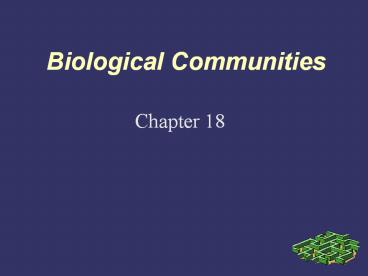Biological Communities PowerPoint PPT Presentation
1 / 23
Title: Biological Communities
1
Biological Communities
- Chapter 18
2
Species often evolve in response to each other
- Interactions among species are the result of a
long term relationships in which organisms adjust
to one another - Insects and flowers
3
- Coevolution back and forth evolutionary
adjustments between interacting members of an
ecosystem
- Symbiosis
- When two or more species live together in a
close, long-term association.
4
- Parasitism when one organism feeds on and
usually live on or in another - Example Ticks and dogs
5
- Mutualism a symbiotic relationship in which
both benefit from the relationship - Example flowers and bees (plants
pollin- ated, bees food)
Commensalism a relationship in which one
organism benefits and the other neither is
benefits or is harmed Example Spanish moss and
trees -trees are not hurt nor benefit, but the
moss benefits from additional sunlight
6
- Common Use of Scarce Resources leads to
competition - Organisms compete for food, space, light,
minerals, and water - Resources must be in short supply if competition
occurs - Competition can limit how species use resources
- Competition can lead to extinction or elimination
of a species
7
- Niche the role of a species in a
ecosystem - How does the organism affect the environment
- If niches overlap it may cause competition
- Niches can vary in size
NOT a part of a teacher's niche!!!
Jaguars eat mammals and fish give birth from
June to August during the rainy season and hunt
by day and by night (these are all a Jaguar's
niche)
8
Major Biological Communities
- Climate largely determines where species lives
- Climate is the prevailing weather conditions of
an area - - the two most important elements of climate are
Temperature and Moisture
9
Temperature most organisms are adapted to a
particular range of temperatures (ex. the growing
season of plants)
Moisture all organisms require water, so the
patterns of rainfall determine an areas life-forms
p. 391
10
Biome a major biological community that
occurs over a large area of land
11
Types of Terrestrial Biomes
- Tundra
- Taiga
- Desert
- Grassland
- Temperate Forests
- Tropical Rain Forests
12
Tundra
- extremely short growing season (6 to 10 weeks)
- long, cold, dark winters (6 to 10 months with
mean monthly temperatures below 32 F or 0 C.) - low precipitation (less than ten inches/year)
- Permafrost (permanently frozen ground about 3 ft
below surface prevents drainage)
13
Foxes, owls, caribou, lemmings live here ...
14
Taiga
(Tahy guh)
- Long, severe winters and short summers (50 to 100
frost-free days) are characteristic, as is a wide
range of temperatures between the lows of winter
and highs of summer. - Mean annual precipitation is 15 to 20 inches,
but low evaporation rates make this a humid
climate.
15
Vegetation and Animals Conifers (spruce and
firs) beaver, lynx, deer, elk, bears,
16
Deserts
- Temperature Average of 38C (day), average of
-3.9C (night) - Precipitation About 250 mm of rain per year
- Vegetation Cacti, small bushes, short grasses
17
- Animals in the desert coyotes, lizards and
snakes, insects, and even some birds) are adapted
for burrowing to escape the scorching heat of the
desert sun
18
Grasslands
- Temperature Dependent on latitude, yearly
range can be between -20C to 30C - Precipitation About 500 to 900 mm of rain per
year - Vegetation Grasses (prairie clover, oats,
wheat, barley, coneflowers)
19
Bison, antelope, prairie dog
20
Temperate Forests
- Temperature -30C to 30C, yearly average is
10C, hot summers, cold winters - Precipitation 750 to 1,500 mm of rain per year
- Vegetation Broadleaf trees (oaks, maples,
beeches), shrubs, perennial herbs, and mosses
21
Animals Deer, raccoons, and salamanders are
characteristic inhabitants.
22
Tropical Rain Forest
- Temperature 20C to 25C, must remain warm and
frost-free - Precipitation 2,000 to 10,000 millimeters of
rain per year (6.5 to 33 Feet) (Y-town 3 ft) - Vegetation Vines, palm trees, orchids,
ferns
23
Animals and plants monkeys, cat like mammals,
reptiles, insects, diverse flowers, hard wood
trees, and medicinal plants

